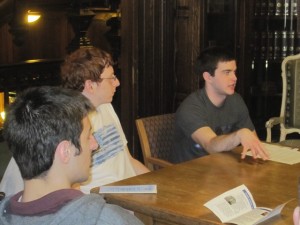Nine students combined their math knowledge with economics to help others in the community this semester.

Students meet with the staff of the Third Street Alliance in Easton.
Through Case Studies in Math Modeling, a course taught by Ethan Berkove, associate professor of mathematics, the students worked to help the Third Street Alliance women’s shelter in downtown Easton operate more efficiently.
In early November, the class went down to Third Street Alliance to meet with the staff. They toured the building and asked questions about the organization. Since then, the students worked in groups to come up with solutions to several issues.
“My group analyzed the financial portfolio for Third Street Alliance,” say Benjamin Greenwald ’12 (Manalapan, N.J.), a double major in mathematics-economics and film & media studies. “We looked for ways to optimize their financial portfolio in order for them to experience financial growth in the coming years.”
Helping the shelter with its asset allocation, the students reconstructed its portfolio and looked for ways to improve it by diversifying funds. Two groups worked on this project and the third helped Third Street Alliance to more efficiently allocate its daily work and projects to employees.
“In each of these projects, we were challenged to use any math concepts that we accumulated in our learning careers to solve the problems correctly and as accurately as possible” says Greenwald. “To succeed, we had to think critically and creatively to consider every possible factor that might go into modeling a problem.”
Zachary Pustejovsky ’12 (Arlington, Mass.), a mathematics-economics major, says the real-world aspect of the course has really kept it interesting. “This isn’t an easy course, but when you’re solving these interesting problems on your own it goes by quickly,” he explains. “There’s a creative aspect to this course that isn’t found in most math classes.”
Greenwald is planning on pursuing a career in either the film or television industries, possibly as a producer.
“My initial goal was to take courses that combined the mindset of a mathematician and an economist, and this class is a perfect example of that sort of interdisciplinary thinking. Luckily for me, producers need to have both creative and economical minds to succeed on both the art side and business side. I’m hoping that the fusion of my two majors will help me to succeed in reaching that goal.”
Case Studies in Math Modeling gives students experience in solving problems with a real-world feel, says Berkove, who has arranged for a community partner each of the three times he’s taught the course. Students work in small teams to decide what mathematical tools would best help them analyze the problem. They perform the analysis and present their results in oral presentations and written reports.
“Real problems rarely have the feel of problems in a calculus course — or many other courses on campus, for that matter,” he says. “Real problems tend to be generally stated or vague, and it is often not initially clear which techniques, if any, can be applied to solve them. In addition there is no answer key available, so rather than trying to get the ‘right answer’ it’s important to develop a reasonable solution and determine how to justify that the solution is reasonable.”

1 Comment
nice of those kids to help out
Comments are closed.